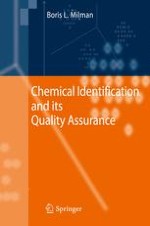2011 | OriginalPaper | Chapter
5. Target Identification in Methods
Author : Boris L. Milman
Published in: Chemical Identification and its Quality Assurance
Publisher: Springer Berlin Heidelberg
Activate our intelligent search to find suitable subject content or patents.
Select sections of text to find matching patents with Artificial Intelligence. powered by
Select sections of text to find additional relevant content using AI-assisted search. powered by
